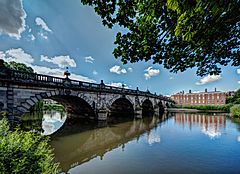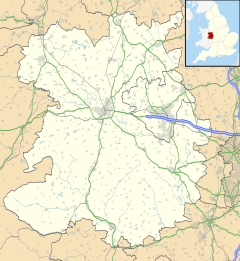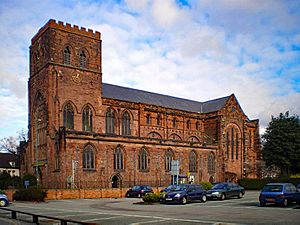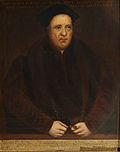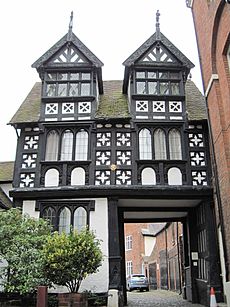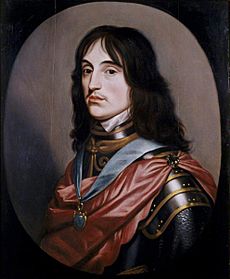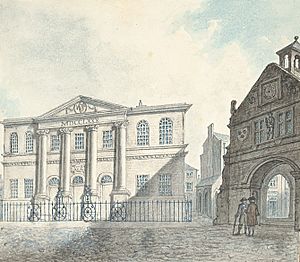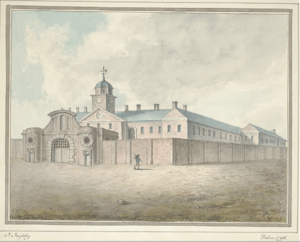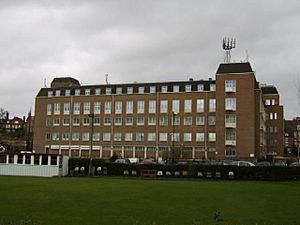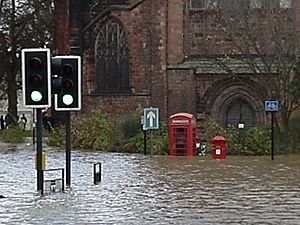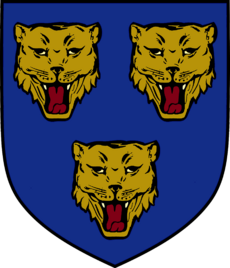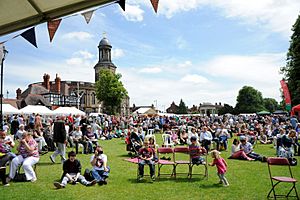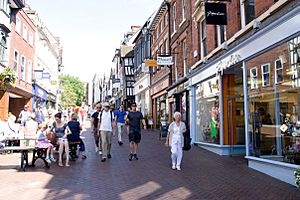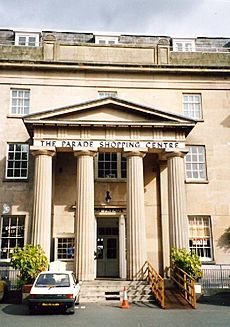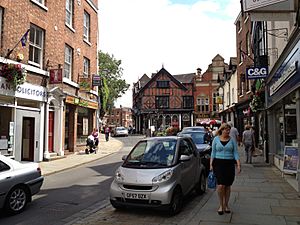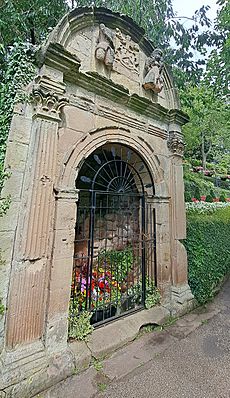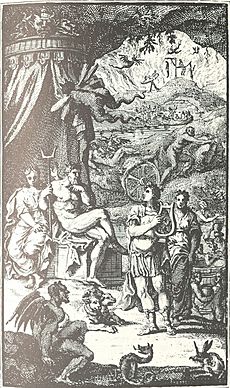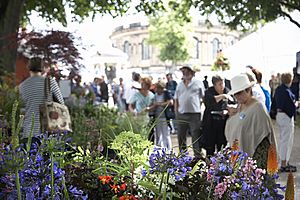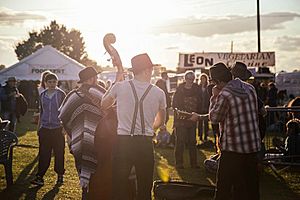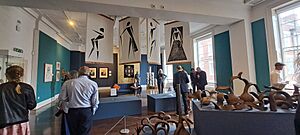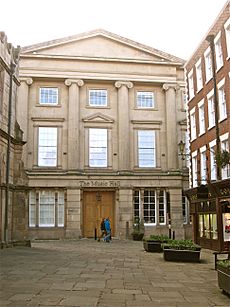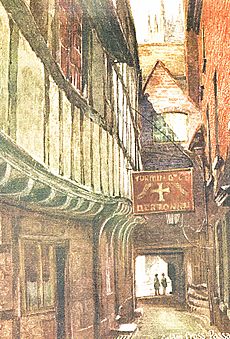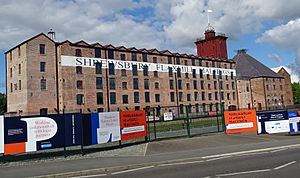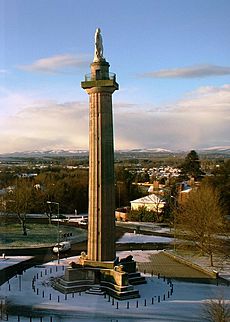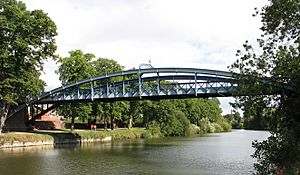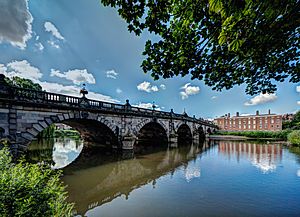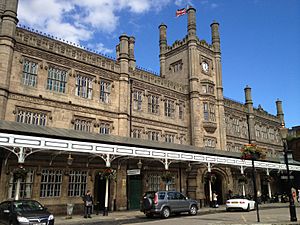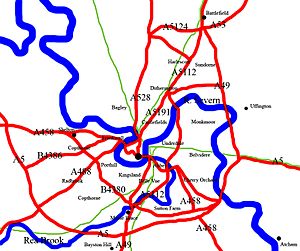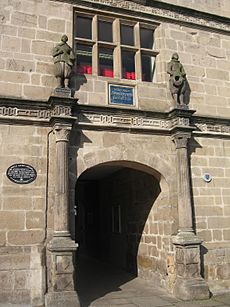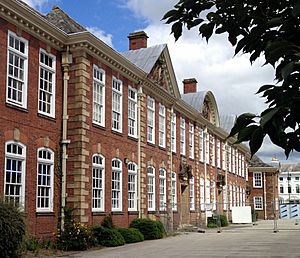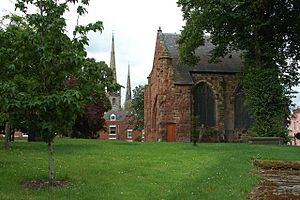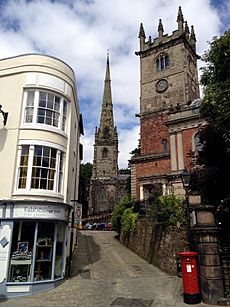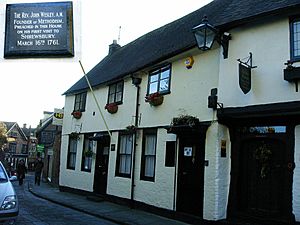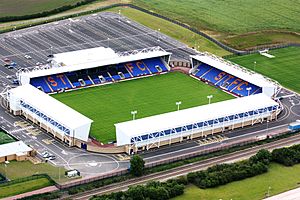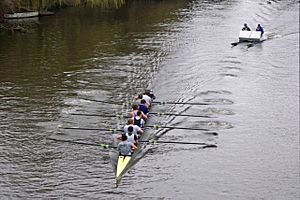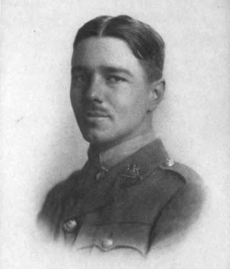Shrewsbury facts for kids
Quick facts for kids Shrewsbury |
|
|---|---|
| Market town and civil parish | |
|
Clockwise from top: Shrewsbury skyline, Shrewsbury Castle, English Bridge and The Square |
|
| Population | 76,782 (2021 Census) |
| OS grid reference | SJ 4915 1253 |
| Civil parish |
|
| District |
|
| Shire county | |
| Region | |
| Country | England |
| Sovereign state | United Kingdom |
| Post town | SHREWSBURY |
| Postcode district | SY1 SY2 SY3 |
| Dialling code | 01743 |
| Police | West Mercia |
| Fire | Shropshire |
| Ambulance | West Midlands |
| EU Parliament | West Midlands |
| UK Parliament |
|
Shrewsbury (pronounced SHROHZ-bər-ee or SHROOZ-bər-ee) is a historic market town in Shropshire, England. It sits on the River Severn, about 33 miles (53 km) northwest of Wolverhampton. In 2021, the town had a population of 76,782 people. It is the main town of Shropshire.
Shrewsbury has a long history, going back to Anglo-Saxon times. Its town centre still has many of its original medieval streets. There are over 660 listed buildings, including old timber-framed houses from the 1400s and 1500s. Shrewsbury Castle and Shrewsbury Abbey were built by the Normans in the late 1000s. The famous scientist Charles Darwin was born here. The town has also played a part in English culture, especially in drama and dance.
Located about 9 miles (14 km) east of the England–Wales border, Shrewsbury is a busy centre for trade in Shropshire and parts of mid-Wales. It has many shops and businesses, as well as light industry. Major roads like the A5 and A49 meet near the town. Five railway lines also connect at Shrewsbury railway station.
Contents
- The Name of Shrewsbury
- Shrewsbury's History
- Town Government
- Geography of Shrewsbury
- People of Shrewsbury
- Shrewsbury's Economy
- Culture in Shrewsbury
- Royal Visits to Shrewsbury
- Festivals and Events
- Museums and Attractions
- Media in Shrewsbury
- Food and Drink
- Shrewsbury's Architecture
- Transport in Shrewsbury
- Education in Shrewsbury
- Religious Sites
- Sports in Shrewsbury
- Famous People from Shrewsbury
- See also
The Name of Shrewsbury
In old English, the town was called Scrobbesburh. This name might mean "Scrobb's fort" or "the strong place in the bushes." Over time, this name changed into "Shrewsbury."
Its Welsh name, Amwythig, means "fortified place."
Shrewsbury's History
Early Times
People lived in the Shrewsbury area a very long time ago. Evidence of religious sites from before 2,000 BC has been found. This makes it one of Britain's oldest places of worship. Tools and even parts of an Iron Age sword have also been discovered.
Roman and Post-Roman Period
Archaeologists found a large Roman settlement near Shrewsbury. It was along a Roman road that connected two important towns. In 2009, a huge collection of over 9,000 Roman coins, called the Shrewsbury Hoard, was found nearby.
Some historians believe Shrewsbury was refortified by people escaping a plague in the Roman town of Uriconium. There is also a story that Shrewsbury was once called Pengwern, the capital of an old Welsh kingdom.
Saxon Times
In the late 700s, it is thought that Offa, a powerful king, took control of the town. He might have started the first church in Shrewsbury.
By the early 900s, Shrewsbury had its own mint where coins were made.
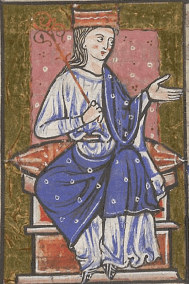
In 914, Æthelflæd, daughter of Alfred the Great, made Shrewsbury stronger to protect it from Viking raiders. She also brought the bones of St Alkmund to the town.
Norman Times
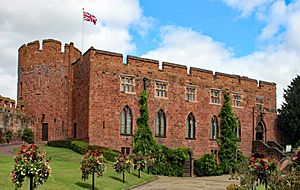
After the Norman Conquest, William the Conqueror gave Shrewsbury to Roger de Montgomery. Roger became the Earl of Shrewsbury. He built Shrewsbury Castle in 1074. Some discoveries suggest there might have been a fort there even before the Normans.
Roger also started Shrewsbury Abbey, a Benedictine monastery, in 1083.
In 1102, the next Earl, Robert of Bellême, rebelled against King Henry I. The king took control of the town. In 1138, King Stephen attacked and captured Shrewsbury Castle during a time of civil war.

In 1138, the bones of St Winifred were brought to Shrewsbury Abbey. Her shrine became very popular later on.
In 1234, Prince Llywelyn ab Iorwerth of Wales attacked Shrewsbury, burning parts of the town. In 1283, King Edward I held a special meeting of Parliament in Shrewsbury. Here, he sentenced the last native Prince of Wales, Dafydd ap Gruffydd, to death.
Middle Ages
The Black Death hit Shrewsbury hard in 1349, causing many deaths.
In 1394, a big fire destroyed much of St Chad's church and many timber houses in the town. King Richard II even cancelled the town's taxes for three years to help with repairs. In 1398, Richard held another important Parliament in Shrewsbury.
In 1403, the Battle of Shrewsbury was fought just north of the town. King Henry IV fought against Henry Percy (Hotspur) and won.
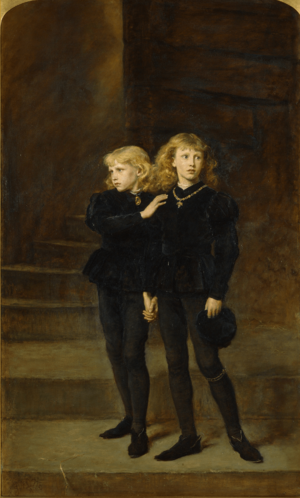
One of the famous Princes in the Tower, Richard of Shrewsbury, was born here in 1473. His older brother, Edward V, also lived in Shrewsbury as the Prince of Wales.
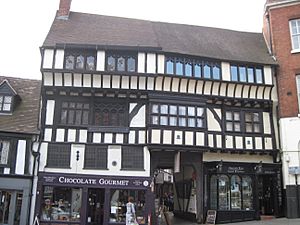
In 1485, before the Battle of Bosworth Field, Henry Tudor marched through Shrewsbury. He was allowed into the town after a clever trick by the town's leader, Thomas Mytton. Henry stayed in a building now known as Henry Tudor House.
Reformation Period
During the Dissolution of the Monasteries, Shrewsbury's monasteries were closed in 1540. King Henry VIII wanted to make Shrewsbury a cathedral city, but the town leaders said no. This is where the nickname "Proud Salopians" comes from, meaning they were proud of their town.
Council of Wales and the Marches
The Council of Wales and the Marches was set up in the 1470s, with its main office in Shrewsbury. This council helped govern Wales and the border areas. It dealt with many types of cases, from helping poor people to investigating crimes.
In 1551, there was a serious outbreak of sweating sickness in Shrewsbury. A doctor named John Caius came to help. He later wrote an important book about the disease.
Early Modern Times
Shrewsbury grew wealthy in the 1500s and 1600s. It was a major centre for the wool trade with Wales, using the River Severn for transport. This led to the building of many grand houses.
King Edward VI also allowed the creation of a free school, which later became Shrewsbury School.
English Civil War
During the English Civil War, Shrewsbury was a strong base for the Royalists (supporters of the King). King Charles I stayed in the town in 1642. Prince Rupert, a Royalist leader, set up his headquarters here in 1644.
Shrewsbury was captured by Parliament's forces in 1645.
Georgian and Victorian Eras
By the 1700s, Shrewsbury was an important market town and a stop for stagecoaches traveling to London and Ireland. Many old coaching inns from this time still exist today.
A new town hall was built in 1730. Later, in 1837, a bigger building for the town and county government was built.
Robert Clive, a famous soldier and politician, was mayor of Shrewsbury in 1762 and its Member of Parliament.
St Chad's Church collapsed in 1788. A new, round church was built in a different spot just four years later.
In the Industrial Revolution, the Shrewsbury Canal opened in 1797, helping to transport goods.
HM Prison Shrewsbury, built in the Georgian period, was once seen as a very modern prison. It closed in 2013.
20th and 21st Centuries
Shrewsbury was not badly damaged by air raids in World War II. This means many of its old buildings are still standing.
Between 1962 and 1992, there was a secret nuclear bunker in Shrewsbury. It was built to warn people about nuclear attacks during the Cold War. Today, it's a veterinary practice.
In 1992, the IRA targeted Shrewsbury with bombs. One bomb damaged Shrewsbury Castle's museum.
Since the late 1990s, Shrewsbury has faced severe flooding from the River Severn. New flood defences were built in 2003, which have helped protect the town centre.
Shrewsbury won the "West Midlands Capital of Enterprise" award in 2004. The town has growing business parks and new homes are being built.
In 2009, Shrewsbury Town Council was formed, bringing back the town's traditional coat of arms. In 2021, a lost town seal from 1425 was found.
Town Government
Shrewsbury has had official documents, called charters, from various kings and queens since Henry I. These charters gave the town special rights.
Shrewsbury is the main administrative centre for Shropshire Council, which governs most of Shropshire. Their headquarters are at the Shirehall.
Shrewsbury is also a parliamentary constituency. The current Member of Parliament is Julia Buckley of the Labour Party.
Town Council
| Shrewsbury Town Council | ||||||||
|---|---|---|---|---|---|---|---|---|
| Year | Lab | Lib | Con | Grn | ||||
| 2009 | 3 | 2 | 12 | 0 | ||||
| 2010* | 4 | 2 | 11 | 0 | ||||
| 2012* | 4 | 3 | 10 | 0 | ||||
| 2013 | 7 | 5 | 5 | 0 | ||||
| 2017 | 7 | 3 | 6 | 1 | ||||
| 2021 | 7 | 6 | 2 | 2 | ||||
| The changing political make-up of the town council – * = by-election | ||||||||
Shrewsbury got its own town council in 2009. Before that, the mayor of the wider Shrewsbury and Atcham area also acted as the town's mayor. The town council meets at Livesey House.
Town's Coat of Arms
The coat of arms for Shrewsbury Town Council shows three "loggerheads" (which are like leopards). The motto is Floreat Salopia, a Latin phrase meaning "May Shrewsbury Flourish."
Town Connections
Shrewsbury was twinned with Zutphen in the Netherlands from 1977 to 2018. The Royal Navy submarine, HMS Talent, was also connected with Shrewsbury.
Geography of Shrewsbury
Shrewsbury is about 14 miles (23 km) west of Telford and 43 miles (69 km) west of Birmingham. It's about 153 miles (246 km) northwest of London. The border with Wales is only 9 miles (14 km) to the west.
The town centre is built on a hill, which is about 246 feet (75 meters) above sea level at its highest point. The River Severn, the longest river in the UK, flows around the town centre in a big loop. The Rea Brook, a smaller river, joins the Severn in Shrewsbury. Parts of the Rea Brook Valley are a country park. The town can sometimes experience flooding from these rivers.
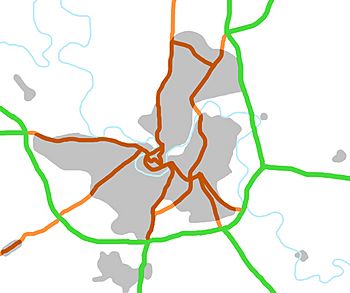
Atcham
Hanwood
Bicton
Upton
Magna A5 (TELFORD) ->
Uffington
TC
Underdale
Belvidere
Monkmoor
Belle Vue
Meole Brace
Sutton Farm
Emstrey
Kingsland
Porthill
Frankwell
Shelton
Bicton
Heath Copthorne
Radbrook
Nobold
Castlefields
Bagley
Harlescott
Battlefield
A clickable link map of Shrewsbury showing suburbs and surrounding villages.
|
Climate and Weather
Shrewsbury has a moderate climate, similar to the rest of Shropshire. It gets about 76 to 100 cm (30 to 39 inches) of rain each year. The town is in the "rainshadow" of the Cambrian Mountains, which means it gets less rain than areas closer to the coast.
The nearest weather station is at Shawbury, about 6.5 miles (10.5 km) northeast of Shrewsbury. Shrewsbury's location in a low plain means it has its own unique weather. It can have a very wide range of temperatures, from very hot summers to very cold winters.
People of Shrewsbury
In 2021, Shrewsbury had a population of 76,782. Most people in Shrewsbury are White (72,975). There are also people of Asian, Black, Arab, and Mixed backgrounds.
Most people in Shrewsbury are Christian (52.7%). A large number (39.1%) say they have no religion. There are also smaller communities of Muslims, Sikhs, Buddhists, Hindus, and Jewish people.
Shrewsbury's Economy
For a long time, Shrewsbury was known for its wool trade. Later, it used the River Severn and canals to transport goods. Unlike many other towns, Shrewsbury never became a big centre for heavy industry.
Today, Shrewsbury focuses on transport, services, and professional jobs. This is because of its location on the A5 road, which is an important route to North Wales.
The town is home to the local and county councils, which provide many jobs. Shrewsbury also has many independent shops, cafes, and restaurants. About four out of five jobs in the town are in the service industry, including retail and food.
Shrewsbury has two main shopping centres: The Darwin shopping centre with big chain stores, and The Parade Shopping Centre with independent shops. There are also large supermarkets around the town.
Tourism is important to Shrewsbury's economy, bringing in about £115 million in 2001. The town attracts many visitors, both for day trips and longer stays. Shrewsbury is the only large town for a wide area, especially towards Mid-Wales. This means people from surrounding areas come to Shrewsbury for shopping and services, including healthcare at the Royal Shrewsbury Hospital.
Culture in Shrewsbury
Arts and Performances
Shrewsbury's Quarry Park has been a place for cultural events for centuries. In the past, religious plays were performed there. Later, Shrewsbury School put on plays that even attracted royal attention.
William Shakespeare set parts of his play Henry IV, Part 1 near Shrewsbury. Some people think Shakespeare might have performed in the town himself.
The play The Recruiting Officer (1706) by George Farquhar is set in Shrewsbury.
John Weaver, known as the "father of English ballet," developed his art in Shrewsbury. He also helped create pantomime.
Today, Theatre Severn is the town's main performing arts centre. It has two stages and hosts many shows. The old theatre, the Music Hall, is now the Shrewsbury Museum and Art Gallery.
Royal Visits to Shrewsbury
Many members of the Royal Family have visited Shrewsbury over the years:
- The Duchess of Kent and Princess Victoria visited in 1832.
- George V visited in 1914.
- Queen Mary visited for shopping in 1925.
- Elizabeth II and Prince Philip, Duke of Edinburgh visited in 1952 and 1967.
- Charles, Prince of Wales (now King Charles III), visited in 1978 and 2001.
- Queen Camilla visited in 2024.
Festivals and Events
Shrewsbury hosts the "longest running flower show in the world." The annual Shrewsbury Flower Show takes place in August and attracts about 100,000 visitors. It features many displays and ends with fireworks.
The Shrewsbury Folk Festival is held every August bank holiday. People travel from all over the UK to attend.
The Shrewsbury Arts Trail showcases modern art, including sculptures and exhibitions.
The town celebrates its connection to Charles Darwin with an annual Darwin Festival in February. This event includes lectures, dance, and music.
Other events include the Shrewsbury Bookfest, Food Festival, Dragon Boat Race, and the Coracle World Championships.
Museums and Attractions
The Shrewsbury Museum and Art Gallery is in the town square. It is located in the old music hall and a 13th-century mansion.
The Old Market Hall is a cinema that opened in 2004. It shows films from around the world.
Other museums include the Soldiers of Shropshire Museum at Shrewsbury Castle and the Coleham Pumping Station, a restored steam-powered station.
The National Trust owns the last remaining Town Walls Tower from the 14th century. You can even rent it as a holiday cottage!
Shrewsbury has some very old public houses (pubs) and coaching inns:
- The Golden Cross is believed to be the oldest pub in Shrewsbury, dating back to 1428.
- The King's Head has a 14th-century wall painting.
Media in Shrewsbury
Shrewsbury has two local newspapers: the Shropshire Star and the Shrewsbury Chronicle, which started in 1772.
Local TV news is provided by BBC West Midlands and ITV Central.
There are also several radio stations that serve Shrewsbury and Shropshire, including BBC Radio Shropshire, which is based in the town.
Food and Drink
Shrewsbury cakes (or biscuits) are crisp, often lemon-flavoured treats. They are mentioned in old cookbooks and even in a play from 1700.
Shrewsbury is also known for a popular Simnel cake recipe. Different towns had their own versions, but Shrewsbury's was well-known.
Beer brewed in Shrewsbury was famous as early as the 1400s. In 1900, there were eight breweries in town. The last large malting house, at Ditherington, closed in 1987. This building, known as the Ditherington Flax Mill, was the world's first iron-framed building. It's now a museum.
A modern brewery, The Salopian Brewery, started in Shrewsbury in 1995.
Shrewsbury's Architecture
Shrewsbury's town centre still has its medieval street plan with many narrow passages. Some of these passages are called "shuts," meaning you can "shoot through" from one street to another. These hidden lanes have many unique shops and pubs.
Some street names are very old and unusual, like Dogpole, Mardol, and Wyle Cop.
The public library is in the old Shrewsbury School building. Above the entrance are statues with Greek words meaning "Lover of learning" and "Much learning."
In the town centre is The Quarry, a 29-acre (12 ha) park by the river. Shrewsbury is known as the "Town of Flowers."
Another important landmark is Lord Hill's Column. At 133 feet 6 inches (40.7 meters) tall, it's the tallest Doric column in England. It honours Rowland Hill, a commander at the Battle of Waterloo.
The Quantum Leap is a modern sculpture in the town centre. It was put up in 2009 to celebrate the 200th birthday of Charles Darwin.
The River Severn almost completely surrounds Shrewsbury's town centre. There are nine bridges crossing the river:
- Frankwell Bridge (pedestrian)
- The Welsh Bridge (built 1793-95)
- The Porthill Bridge (pedestrian suspension bridge, built 1922)
- Kingsland Bridge (a private toll bridge)
- The Greyfriars Bridge (pedestrian)
- The English Bridge (rebuilt in the 1920s)
- The railway station (partly built over the river)
- Castle Walk Footbridge (pedestrian)
- The A5112 Telford Way (for vehicles, bikes, and pedestrians)
Transport in Shrewsbury
Trains
Shrewsbury railway station is a busy hub. You can catch trains to places like Wrexham, Chester, Manchester, Hereford, Cardiff, and Swansea.
The station building looks like an old Tudor house, with a clock tower and carved heads. It's known as the "Gateway to Wales."
Buses
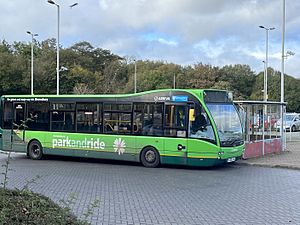
Bus services in Shrewsbury are mainly run by Arriva Midlands. The main bus station is next to the Darwin Shopping Centre. Buses connect the town to Telford, Market Drayton, and Newport. Other companies run services to Welsh towns.
Shrewsbury also has a park & ride system with three car parks on the edge of town.
Roads
Shrewsbury has always been important for road travel. In 1815, Thomas Telford designed a new road from London to Holyhead, which went through Shrewsbury. This road is now the A5. It connects the town to Oswestry and Telford.
The A49 also comes to Shrewsbury from Ludlow and Leominster. The A53 starts in Shrewsbury and goes towards Stoke-on-Trent.
A new road, the North West Relief Road, is being built. It will complete a ring road around the town.
Cycling
Shrewsbury has many cycle routes, both on roads and traffic-free paths. In 2008, it was named a "Cycling Town," which brought funding to improve cycling facilities and encourage more people to cycle.
Education in Shrewsbury
Independent Schools
Shrewsbury School is a famous public school located in Kingsland. It used to be in the town centre, in the building that is now the main county library. Across the river is Shrewsbury High School, an independent school for girls.
Prestfelde School is an independent preparatory school on London Road. It teaches boys and girls aged three to thirteen.
State Schools
Most students in Shrewsbury attend one of the comprehensive schools, such as The Priory School, Meole Brace School, or Shrewsbury Academy. The Wakeman School, which was close to the town centre, closed in 2013.
For further education, students can go to Shrewsbury Sixth Form College or Shrewsbury College. In 2016, these two merged to form the Shrewsbury Colleges Group.
University
University Centre Shrewsbury offers university courses. It was started by the University of Chester and Shropshire Council. Its main campus is in the renovated Guildhall.
Religious Sites
Shrewsbury has several historic churches. St Chad's was rebuilt in 1792 after the original collapsed. St Mary's is a beautiful medieval church from the 12th century. The Norman Shrewsbury Abbey was founded in 1083.
There are many other Anglican churches in Shrewsbury. Methodists, Baptists, and the United Reformed Church also have churches here. John Wesley, a founder of Methodism, first preached in Shrewsbury in 1761.
Shrewsbury has a Roman Catholic Cathedral near the Town Walls, built in 1856.
The town also has a Greek Orthodox Church. In 2013, Shrewsbury's first dedicated Muslim prayer centre opened.
Community Projects
Many community projects in Shrewsbury are run by local churches. The Isaiah 58 project helps homeless people. The Shrewsbury Food Bank provides food and offers advice on money and child bereavement.
Sports in Shrewsbury
Football
Shrewsbury has a professional football club, Shrewsbury Town. They play their home games at the New Meadow stadium. The town also has a semi-professional club, Haughmond.
Rowing
The River Severn is used for rowing by the Pengwern Boat Club and the Royal Shrewsbury School Boat Club. There is an annual rowing regatta in May, which is one of the oldest rowing events.
Rugby
Shrewsbury has a local rugby club called Shrewsbury Rugby Club.
Other Sports
The Shrewsbury Sports Village offers many sports facilities. There are also golf courses. Shrewsbury hosts an annual Sprint Triathlon and a free weekly parkrun in The Quarry.
Famous People from Shrewsbury
Many notable people are connected to Shrewsbury:
Charles Darwin, the famous biologist and evolutionary theorist, was born in Shrewsbury in 1809. His time in the town inspired his interest in nature.
The poet Wilfred Owen lived in Shrewsbury before First World War. The playwright George Farquhar also lived here.
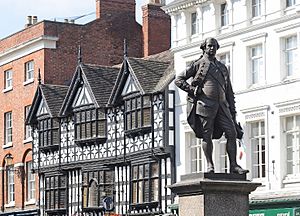
Robert Clive, a key figure in British India, was an MP for Shrewsbury and also its mayor.
Ian Hunter, the lead singer of the 1970s band Mott the Hoople, lived in Shrewsbury. The 1980s pop group T'Pau was formed here.
Famous sports figures include England goalkeeper Joe Hart and golfer Sandy Lyle, who were born in Shrewsbury.
Other notable people include architect John Gwynn, comic book artist Charlie Adlard (who illustrates The Walking Dead), and gardener Percy Thrower.
Flight Lieutenant Eric Lock, a highly successful fighter pilot in World War II, grew up near Shrewsbury.
See also
 In Spanish: Shrewsbury para niños
In Spanish: Shrewsbury para niños





